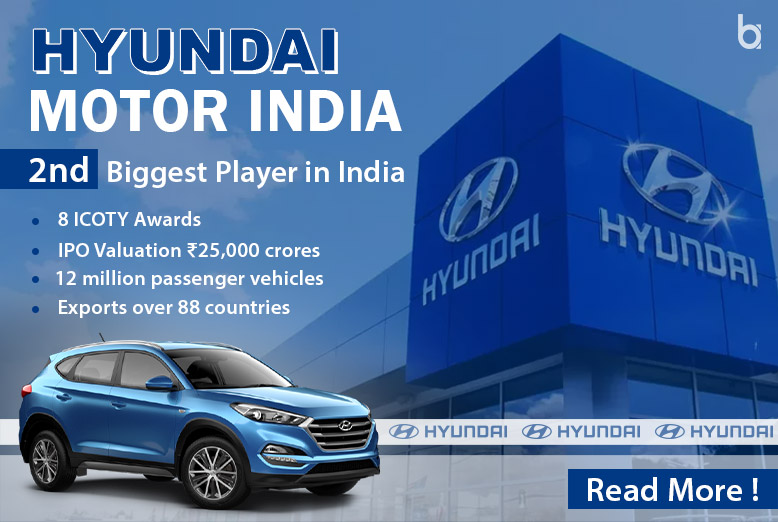Hyundai Motor India, a subsidiary of South Korea’s Hyundai Motor Company, has been operating in India for over 27 years with the only motto of “Progress for Humanity”.
Since its entry in 1996, it has disrupted the Indian market with modern designs and innovative technology. Initially focused on small cars, Hyundai Motor India quickly captured consumer interest through its value-driven offerings.
The company introduced features and specifications that resonated with Indian buyers, enhancing its appeal. Consequently, Hyundai Motor India has emerged as one of the leading automakers in the country.
Now, let’s explore 10 fascinating facts that highlight its market dominance and significant impact on the automotive industry.
1. Hyundai Motor India Became the Highest Automotive Exporter in Just One Decade
Hyundai’s export journey has been remarkable, starting with 500,000 cars exported by 2008 and reaching 3 million by 2020. Models like the Creta and Venue significantly contributed to this milestone, as the company serves 88 countries across five continents. Even during the challenges of the pandemic, Hyundai achieved exports that accounted for 21% of total sales in FY23.
Key Export Milestones:
- 500,000 cars exported by March 2008.
- 1 million exports by February 2010.
- 3 million cars exported by 2020.
Top Export Markets:
| Country | Popular Models | SUV Exports (Units) |
| Mexico | Creta, Venue | 200,000+ |
| South Africa | Creta | – |
Analysis:
- Hyundai’s focus on global demand for compact and reliable SUVs like the Creta solidified its position as India’s top passenger vehicle exporter.
- Consistent exports across diverse regions bolstered its global footprint, enhancing economies of scale and revenue growth.
2. R&D Center: A Hub for Compact Car Innovation
Hyundai’s R&D center in Hyderabad represents its commitment to technological advancement. This ₹184 crore investment focuses on compact car innovation, safety, and efficiency. The engineers at the facility have been instrumental in designing models like the Eon and Creta and are pivotal in transitioning toward electric vehicles.
R&D Highlights:
- Facilities: 200,000 sq. ft., CAD/CAE technology.
- Specializations: ADAS, body electronics, and EV development.
- Collaborations: Centers in South Korea, Germany, and the U.S.
Analysis:
- By localizing innovation, Hyundai reduces dependency on global R&D facilities, leading to quicker adaptation to regional market demands.
- The focus on EVs aligns with India’s sustainability goals and positions Hyundai as a leader in the transition to green mobility.
3. IPO Launch: A Landmark Financial Move
The IPO scheduled for October 2024 is a significant milestone for Hyundai Motor India. With a targeted valuation of ₹25,000 crores, the offer-for-sale will grant retail investors access to one of India’s top automotive brands.
Key IPO Details:
- Face Value: ₹10 per share.
- Price Band: ₹1,750 – ₹1,760.
- Stake Offered: 17.5% (~14.2 crore shares)
Investor Allocation Table:
| Category | Allocation |
| Qualified Institutional Buyers | 50% |
| Non-Institutional Investors | 15% |
| Retail Individual Investors | 35% |
Analysis:
- The IPO enhances liquidity and brand equity while enabling Hyundai to gain additional market insights through a diverse shareholder base.
- This move could also raise its profile among investors, fueling future growth initiatives.
4. The Hyundai Santro: A Cultural Icon
Launched on September 23, 1998, the Hyundai Santro disrupted the Indian automobile market with its unique tall-boy design and spacious interiors. It quickly became a cultural icon during India’s liberalization era and was a direct challenge to the Maruti 800.
Key Milestones:
- 1998: Launched as a city car with a 999 cc engine producing 56 PS.
- 1999: 17,627 units sold domestically.
- 2000-2001: Gained momentum, selling around 60,000 units in the first two years.
- 2003: The engine upgraded to a 1.1-litre engine producing 63 PS, with over 120,000 units sold.
- Peak Contribution: At its peak, the Santro accounted for 76% of Hyundai’s total sales in India.
- 2018: Reintroduced after a hiatus with modern features.
- 2022: Discontinued due to shifting consumer preferences towards SUVs and other segments.
Analysis:
- Market Penetration: The Santro quickly gained popularity, surpassing competitors and becoming the go-to family hatchback in India.
- Cultural Impact: It symbolized upward mobility, representing the growing middle class during India’s liberalization.
- Strategic Importance: At its peak, the Santro accounted for 76% of Hyundai’s total sales in India, driving the brand’s success.
- Decline and Legacy: Despite being discontinued twice, the Santro remains key to Hyundai’s success in the Indian hatchback segment.
5. ICOTY Dominance: A Mark of Excellence
Winning the Indian Car of the Year (ICOTY) award eight times highlights Hyundai’s ability to innovate and adapt to customer needs. Models like the Grand i10, Creta, and Venue reflect a focus on safety, performance, and cutting-edge features.
Complete list of Hyundai Motor India’s ICOTY wins:

- 2008 – Hyundai i10
- 2014 – Hyundai Grand i10
- 2015 – Hyundai Elite i20
- 2016 – Hyundai Creta
- 2018 – Hyundai Verna
- 2020 – Hyundai Venue
- 2021 – Hyundai i20
- 2024 – Hyundai Exter
Analysis:
- The consistent recognition strengthened customer trust and brand loyalty.
- This reputation for excellence has translated into sustained sales and leadership in various segments.
6. Sustainability Initiatives and EV Roadmap
Hyundai has committed to investing ₹20,000 crores by 2030 to accelerate EV adoption and sustainability in India. It plans to introduce five new EV models and establish robust charging infrastructure.
Sustainability Initiatives:
- Water Management: 80% self-sufficiency at the Chennai facility.
- Renewable Energy: 10 MW rooftop solar installations.
- Production Capacity: Over 1 million units annually by 2030.
Analysis:
- These initiatives align Hyundai with India’s green energy vision while enhancing its competitive advantage in the EV market.
- A strong focus on infrastructure development ensures scalability and customer convenience.
7. Diverse Product Portfolio: Meeting Varied Needs
Hyundai offers 13 passenger car models, including the Creta, Venue, and the all-electric IONIQ 5, catering to a broad audience. Its commercial vehicle lineup further extends its reach.
Product Highlights:
- Passenger Cars: Grand i10, Creta, IONIQ 5.
- Diverse Offerings: Sold 12 million passenger vehicles in India by 2024.
- Commercial Vehicles: HD170, HD1000.
Analysis:
- The wide product range allows Hyundai to diversify revenue streams and mitigate risks associated with market-specific trends.
- This versatility has enabled Hyundai to maintain a strong 15% market share in India.
8. Hyundai Motor India is set for Sustainability through EVs
Hyundai Motor India is paving the way for a greener future by heavily investing in electric vehicles (EVs). With plans to invest ₹20,000 crores (approximately $2.4 billion) by 2030, the company aims to strengthen its EV portfolio and infrastructure. This investment includes the development of five new EV models, including the much-anticipated electric Creta, set to launch in 2025.
Key Highlights:
- EV Model Line-up: Hyundai will introduce five new EVs by 2030, with the electric Creta leading the charge.
- Manufacturing Capacity: Hyundai’s third plant will produce 75,000 EV battery packs annually.
- EV Infrastructure: Plans to establish 485 EV charging stations across India.
- Collaboration: Partnership with Exide Energy Solutions for localized battery production.
Sustainability at its Core:
Hyundai’s Chennai plant already boasts a 10 MW rooftop solar installation and is 80% self-sustainable in water usage, with a goal to achieve 100% sustainability by 2027.
| Metric | Current Status | Target by 2030 |
| EV Market Share | 2% | 22% |
| Charging Stations | 150+ | 485 |
| Battery Production | 0 | 75,000 units/year |
Analysis:
- Positioned as a key player in India’s EV revolution, rivaling Tata Motors.
- Focuses on localized production, cost-effective manufacturing, and sustainable operations.
- Reduces dependency on imports while attracting eco-conscious consumers.
- Strengthens its brand as a future-ready automaker in domestic and export markets.
9. Hyundai operates over 1000 sales points across India
Hyundai Motor India boasts an extensive dealership and service network that ensures a strong presence in urban and rural areas. With over 1,000 sales points and 1,500+ service outlets, Hyundai delivers a seamless customer experience across India.
Features of the Sales Network:
- Strategic Placement: Sales points are distributed to target both metro cities and tier-2/3 towns.
- Digital Integration: The “Click to Buy” platform simplifies online purchases and enhances convenience for customers.
- After-Sales Support: Dedicated service outlets cater to repair, maintenance, and spare parts requirements.
Performance Metrics:
| Aspect | Number in 2024 |
| Sales Points | 1,000+ |
| Service Outlets | 1,500+ |
| Online Sales (2024 share) | 10% |
Analysis:
- Combines offline dealership strength with digital platforms like “Click to Buy.”
- Appeals to tech-savvy urban buyers and traditional rural shoppers.
- Ensures widespread brand visibility and high customer satisfaction.
- Rural outreach taps into untapped markets, driving long-term sales growth.
10. Hyundai Motor India is the Second-Biggest Player in the Indian Automotive Market
Hyundai Motor India holds a significant position in the Indian automotive market with a 14.9% market share. Since its entry in 1996, it has grown into a key player, offering popular models like the Creta, Venue, and i20.
Key Milestones:
- FY 2023-24: Domestic sales reached 6.14 lakh units, showing an 8.3% year-on-year growth.
- Overall Sales: 7.77 lakh units sold, an 8% increase from 7.20 lakh units in FY 2022-23.
- Revenue: Rs 60,307.58 crore in FY 2022-23, up from Rs 47,378.43 crore in FY 2021-22.
- Profit Growth: Consolidated net profit rose by 62.3% to Rs 4,709.25 crore.
Market Share Distribution as of September 2023:
| Manufacturer | Market Share |
| Maruti Suzuki | 41.6% |
| Hyundai Motor India | 14.9% |
| Tata Motors | 12.3% |
| Mahindra & Mahindra | 11.4% |
Analysis:
- Market Position: Hyundai continues to grow with a 14.9% share, significantly ahead of Tata and Mahindra.
- Sales Growth: An 8.3% year-on-year increase in domestic sales highlights Hyundai’s ability to meet consumer demand.
- Revenue & Profit: Hyundai’s revenue and profit figures demonstrate its robust performance in the competitive market.
Key takeaways
These efforts have enabled the company to maintain its competitive edge and drive sustainable growth in a dynamic market.
- Investment in EVs positions Hyundai as a future-ready automaker, reducing import dependency and attracting eco-conscious consumers.
- Omnichannel strategy ensures wide customer reach, combining digital convenience with traditional dealership strength.
- Rural outreach taps into unexplored markets, boosting long-term sales potential.
- Localization efforts enhance supply chain resilience, lower costs, and support the “Make in India” initiative.
- Strong focus on affordability and quality tailors Hyundai’s offerings to price-sensitive Indian consumers.
By balancing innovation with market-specific strategies, Hyundai motor India has secured its place as a leader in India’s automotive sector, paving the way for continued success in the years to come.












